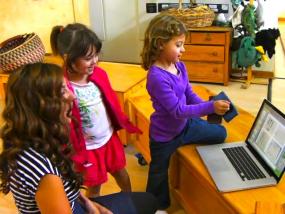Single Sound Has a Story

Words neither look nor sound like their referent. The shape of the letters C A T does not hint at what the word means. Saying "cat" is not the same as saying "meow." We understand such symbols only by participating in social discourse with others who have learned these words. The words are a type of social contract, an agreement to accept the dictionary meaning. Other symbols contain in their visual form or sound some hint at what they mean. These symbols are called icons, such as a drawing or a voiced noise ("meow") frequently heard in the presence of the referent. For young children, creating icons helps them understand the basics of how symbols work. Indeed, iconic symbols in an advanced form are considered art. The art comes into play when the icon is more than a cliché, when it expresses some subtle dimension of the referent missed in the cliché. In this video, the children are revisiting a symbol drawn to represent themselves. Rosie (in pink) describes her symbol and its meaning: a memory of her dad’s birthday, when she and her family were throwing leaves in the pond at the botanical gardens. Monica, the music teacher, praises Rosie's drawing by describing its features and suggesting how the "logo" for Rosie could be used if printed, such as a signature for work not to be removed. At Monica's invitation to invent an iconic sound, Rosie (at 01:52) voices a sound like “whooosssshhhhh” and gestures "falling" with her hands, a gesture Monica uses to help Rosie understand the question. Instead of recording the voiced sound into the computer, Monica encourages the small group of children to find an instrument that makes a similar sound. After the children test a number of instruments, Brooke discovers the sand paper blocks and uses them to create a whoossshhhing sound (03:00). Notice how Brooke uses a continuous circular motion of the sandpaper blocks as she looks at the drawing (03:23). Does she think the continuous whisking noise provides a better iconic symbol for the falling leaves than the start and stop sound of rubbing the sandpaper blocks back and forth? (Break at 03:28) The children decide not only to make the sound of the leaves falling, but also the sound of the leaves hitting a rock, the sound created by slapping the blocks together. Monica skillfully involves all of the children as they record only the desired sounds and then listen carefully to the recording to ensure they are happy with the result. Consider the thinking and problem solving revealed in this brief episode. 1. What could I draw that represents something unique to my identity (a memorable day for my family)? 2. Of the set of possibilities, what do I have the skills to draw (falling leaves)? 3. If one could imagine a sound associated with falling leaves, what would it be (the wind that makes the leaves fall)? 4. Is this sound continuous or punctuated (Brooke's circular rubbing of the sandpaper blocks)? 5. How can I add more narrative to the referent as an event (adding the conclusion of hitting the rocks)? Clearly the children use high level thinking to invent iconic symbols, as well as deepen their empathy for ordinary events in nature. Keywords: Fives, Children-Teacher, Computer, Sounds, Symbols, Music Run time: 4 minutes 41 seconds
